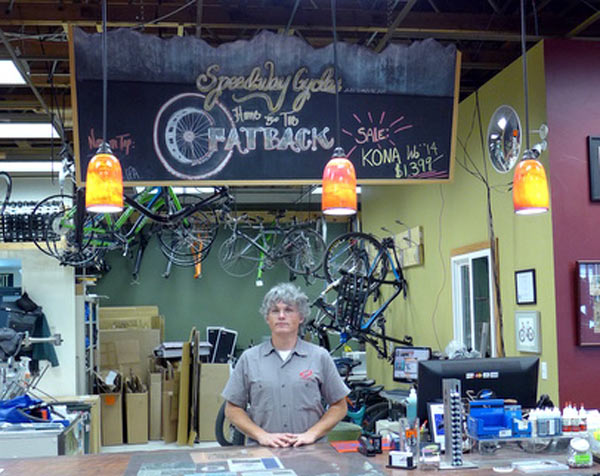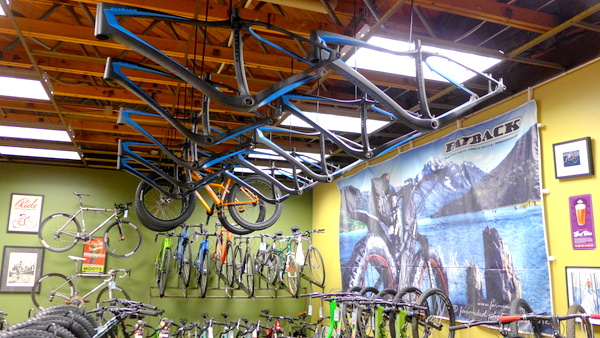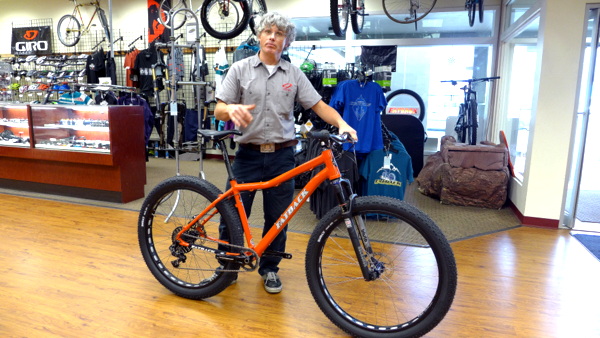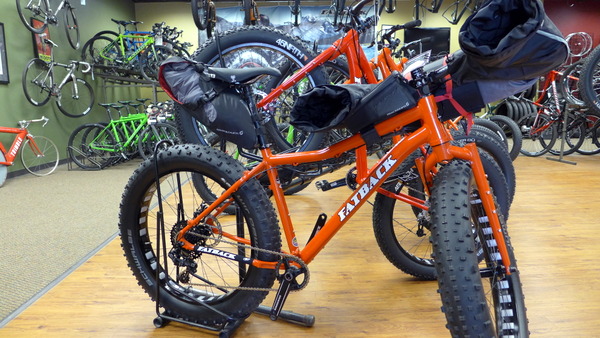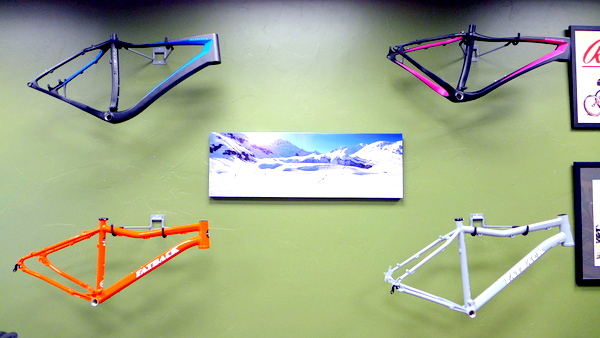
Fatback Cycles lays claim to making the first production, symmetrical fat bike. While this may be a small niche within a niche, it launched what would become the modern fat bike, and the 170mm width is the generally accepted standard, followed closely by 190mm, also pioneered by Fatback.
When a niche explodes, inventors and early pioneers can struggle or thrive, depending on how they react or continue to forge further ahead. We recently went to Anchorage to hear right from the guys at Fatback how they plan to keep true to their roots in the rapidly expanding fat bike market. Hear what they have to say…
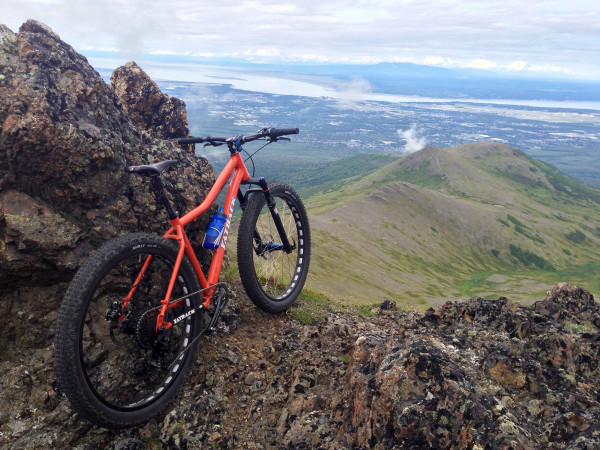
Speedway Cycles in Anchorage is the home of Fatback. Walking in, the shop had a gallery feel to it, showing beautiful bikes, in a spacious and welcoming way. A ceiling full of their carbon fiber Corvus hung ready and waiting for their future owner to take them out in the wild. There was a feel to the place that made you want to get out and away, as far as you can go on a floatation bike in the Alaska wilderness. Jason Hill, store manager, showed us around the shop as we discussed the future of fat bikes.
BIKERUMOR: Fat biking has exploded in the past few years, and most recently, we have seen the large brands adopt the bikes. How has this affected your business? Has it been a “rising tide raises all ships”, or has it taken away from your original business?
Greg Matyas (Fatback): It’s raised all ships. As you have seen, supply has been the problem over the years, not demand. We produce a premium product, tested in the most harsh conditions anywhere. Savvy customers recognize this. We Know what works, and what doesn’t. Most of the new product on the market now will have to learn that the hard way.
BIKERUMOR: Fat bikes have probably always been cool to you. Now they are cool to mainstream, seeing them even in Mountain Khakis and Lululemon catalogs. What is your take on this new found popularity? Good or bad for the sport?
Greg Matyas: Well I’m the last guy on the planet to follow trends. I do this because I love it. I’m sure it’s fine for the sport, but at the same time, many of those who jumped on board were the same people whispering “that’s the stupidest f***ing bike on the planet” at the shows just a few years ago.
BIKERUMOR: You have continually been on the forefront of what fat bikes are, and where they are heading. What’s next?
Greg Matyas: We’ll see more niche product. We are working on some new ideas that will remain unannounced for now. I don’t know about this full suspension thing though. Certainly not for winter. The Blutos are going to fail under normal winter conditions where we are.
BIKERUMOR: Gary Fisher has said that fat bikes have the potential to become 20% of the total mountain bike market. Agree or disagree?
Greg Matyas: I don’t know about that. If you have a need for floatation, be it sand or snow, fat tire bikes are as fun as it gets. That I’m sure of. Guess I wouldn’t rule it out. I haven’t gotten anyone into the sport who doesn’t love it.
BIKERUMOR: Most large companies talk about their fat bike as “fun”. All bikes are obviously fun. What are they missing in their attempt to create a reason to purchase a fat bike?
Greg Matyas: I think they are just repeating what those of us who’ve been involved for years have been saying. Honestly, most of the designers have probably never been on the bikes in their natural environment. We love this stuff. Every day.
BIKERUMOR: You are synonymous with Alaska fat biking, partly because of your brand, partly because of your shop, and partly because of the events you are associated with. Where do you want to go next with your fat bike that is not in Alaska?
Greg Matyas: I’m thinking a man made glacier at Disneyland! In all seriousness, we are working developing our international sales, as well as better representation in certain regions of the country. I’m not chasing the LuLuLemon crowd. Our customers ride. They don’t turn around and go home if the trails aren’t packed, and they don’t buy because it’s the latest trend. They are out there, regardless of weather. And providing feedback. They are the best customers.
BIKERUMOR: Tell me a bit more about what started you down this path of your own company.
Greg Matyas: Riding bikes in winter has always been a part of my life. I grew up alpine and Nordic ski racing here in AK, so I really liked being on snow. We would ride the beach in mid-winter back in the 80’s. I rode snow quite a bit to prepare for the Olympic Training Center in 86 since I have little patience for trainers. It wasn’t too long after that before I got married and had children, so there just wasn’t time to compete. As my kids got older and I had a little more freedom, I started entering winter cycling events. Mostly shorter distance, as I have battled low back and hip issues for over a decade. Winter XC races and ice crits. These were really fun, competitive events, always with a healthy dose of partying afterwards.
As things evolved, I got more interested in the longer distance races, but my health had not improved. I couldn’t just stand by and watch everyone else suffer, so I decided to do the Susitna 100. Pete Basinger was working for me at the time, so we rode together quite a bit. He introduced me to Jeff Oatley. Those two guys have dominated the sport for many years. Good company to keep. After having surgery, I decided to try the Iditarod Trail Invitational in 2011, and also made it into the White Mountains (the field is capped at 65). Using Rolfing, acupuncture, active release therapy, chiropractic, nerve blocks and cortisone injections, I was able to do some training. The races both went really well, but were not worth the effort needed to be competitive, so that was that. My time is mostly spent doing product testing on as diverse of terrain as possible here. Both summer and winter. We have done some amazing beach trips that include pack rafting and fishing, brown bears and even walrus! I enjoy getting feedback from all the guys racing as well as bike packing on our products. Product development is what gets me out of bed in the morning.
BIKERUMOR: Jason, you have been showing me pictures of some rides way up high on a 29+ equipped Fatback. Why 3″ tires instead of 4″+ tires?
Jason Hill: Personally I think that is part of what makes the Fatback such a great and versatile bicycle; being able to go from fat bike wheels to a 29er+ and it ride just as well and capable set up either way. I have been doing some rides up high in the mountains where we can ride in a wide open area, off of any trail, and just riding freely where ever we want to. Here in Alaska, there is lots of land where that is allowed.
BIKERUMOR: Any plans for a 3″ tire specific model?
Greg Matyas: We have been enjoying plus size tires. They make sense for many conditions. We are working on a few projects we are keeping under wraps at the moment, but plus size wheels are always kept in mind, in both 27.5 and 29″.
